CPVC pipe and fittings offer a less expensive and more convenient way to provide fire protection in light hazard and limited ordinary-hazard settings
CPVC pipe and fittings have continued their rise in popularity for fire sprinkler systems in residential and other light-hazard settings. The advantages are straightforward: the material is less expensive than metal and offers quicker and safer assembly because installers do not need flame or heavy equipment to join components. CPVC (chlorinated polyvinyl chloride) is sturdy and reliable, has a 50-year life expectancy, and is resistant to corrosion and deposits that could block water flow.
In this article, we explore the approved uses of CPVC in fire sprinkler systems, provide information about care and storage of CPVC components, and run through a typical installation process.
Do you need to buy CPVC components for a fire sprinkler system? Check out our online selection of pipe, tees, adapters, caps, elbows, and glue.
Good practices for CPVC selection: knowing approved uses and choosing reputable manufacturers
The National Fire Protection Association (NFPA) allows the use of thermoplastic pipe for single- and multi-family housing and other “light hazard” occupancies. CPVC can also be used in rooms rated “ordinary hazard” that do not exceed 400 square feet if they are within an otherwise light-hazard setting.
This rule facilitates the use of CPVC in an entire building that is predominantly light-hazard but includes some rooms of a higher hazard that are accessory or incidental to the predominantly light-hazard use, such as large-scale laundries or kitchens found in condominiums or an institutional facility. CPVC is not listed for use in exposed outdoor settings.
Given their wide range of applications in different industries, not all CPVC pipes and components are listed for use in fire sprinkler systems. NFPA flags this important fact in the 2019 editions of its sprinkler installation standards: NFPA 13: Standard for the Installation of Sprinkler Systems, NFPA 13D: Standard for the Installation of Sprinkler Systems in One- and Two-Family Dwellings and Manufactured Homes, and NFPA 13R: Standard for the Installation of Sprinkler Systems in Low-Rise Residential Occupancies (some emphasis added):
From the 2022 editions of NFPA 13, NFPA 13R, and NFPA 13D
A.7.3.2, A.5.2.12.2, A.5.2.3.2 Not all fittings made to [ASTM standards] as described in [appropriate section], are listed for fire sprinkler service. Listed fittings are identified by the logo of the listing agency..
Accordingly, fire system professionals should confirm via the manufacturer that a product is listed not only for use in fire sprinkler systems but also for a specific use within that system. Listing means that the technology has been tested and approved for that specific application by a qualified safety organization like UL or FM Global.
Manufacturers of CPVC fire sprinkler pipe
Installers should be aware that CPVC from different manufacturers may be, well, slightly different. While some benefits of this thermoplastic are consistent across all makers, CPVC made with different resins and additives can yield varying results, including added performance and resistance to certain chemicals. Therefore, it is important to become acquainted with the reputation and the longevity of the manufacturer, the manufacturer’s testing protocols, and the availability of technical support when making a product selection.
There are numerous manufacturers of CPVC products in the US, including Thermofit Industries (TFI), BlazeMaster, and Spears. These three all have CPVC products listed for residential sprinkler systems that are temperature-rated at 150°F at 175 PSI.
However, BlazeMaster CPVC has an American Society for Testing and Materials (ASTM) 06 rating, while other brands have an ASTM 05 rating. The higher rating may indicate that the pipes have a 25% greater estimated long-term strength, or hydrostatic design pressure, and are less likely to burst at higher temperatures. In addition, BlazeMaster claims its fittings have a greater impact strength than other forms of CPVC pipe. Nevertheless, many users don’t deem all differences critical to performance, and all three manufacturers make quality, listed products that work.
CPVC installation standards vary by installation location
Concealed locations
Concealed installations are typically those located behind a wall or ceiling. A barrier not only helps compartmentalize the heat from escaping into an upper space, which would delay sprinkler activation, but it also protects the pipe itself from high temperatures.
Contractors can install a CPVC system in these spaces but must use sprinklers rated at 225°F or lower and protect the pipe from the usable space by one of the following: a thermal barrier consisting of 3/8” or thicker gypsum wallboard, ½” plywood soffits, or a suspended membrane ceiling with lay-panels or tiles weighing at least .35 lbs./square-foot when installed with metallic support grids. The minimum protection for a residential setting is one layer of ½” plywood.
Exposed Locations
In exposed locations—where it is desirable to not run the material behind a wall, ceiling, or other barrier—fire system professionals must install CPVC components below a flat, horizontal, and smooth surface, and ensure that fire sprinklers are placed at specified maximum distances. For residential sprinklers, ordinary pendent sprinklers should be spaced not more than 15 feet apart, and sidewall sprinklers must be spaced no more than 14 feet apart.
That said, the BlazeMaster installation guide, for example, specifies a lot of scenarios with nuanced specifications. Be sure to check the specific manufacturer installation guide, as there are certain rules that may apply in exposed applications that can affect spacing, the distance from the ceiling, the sprinkler temperature, and even densities.
For those brands listed for use in garages, installers must use CPVC in conjunction with one layer of ½” plywood or a layer of 3/8” gypsum for protection, and employ listed pendent or sidewall sprinklers with a maximum temperature of 225°F.
Unfinished Basements in NFPA 13D residential fire sprinkler installations
Special rules govern the use of CPCV fire sprinkler pipe in unfinished basements and can vary by manufacturer. For example, joist dimensions are specified. When using BlazeMaster, the joist can be 16″ deep and 40′ long with 24″ between each beam (often referred to as 24” “on center”), while for Spears and TFI, the joists have maximum dimensions of 12″ deep, 32′ long, and 16″ on center.
The joist length is enforced in part through rules for blocking, which is the placement of wood or insulation perpendicular to joists in order to trap heat and trigger sprinklers faster in the case of fire. Spears specifies 32′ as the maximum joist length before blocking must be used, while the limit for BlazeMaster is 40′. In addition, any protected space that is larger than 1,000 square feet has to be blocked—divided into smaller spaces—when using lengths of non-BlazeMaster CPVC pipe.
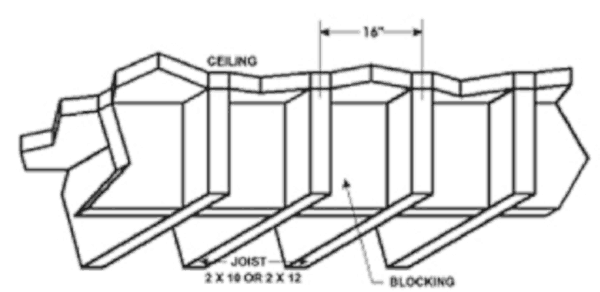
CPVC can be used in basements that have both solid wood joists and composite wood joists. However, BlazeMaster has one set of installation standards and guidelines for both scenarios, while other manufacturers have different procedures for each. Again, make sure to consult the specific manufacturer’s installation instructions when putting in a system.
The space above: CPVC in attics and air plenums
CPVC fire sprinkler products can be installed in attics where the temperature is greater than 150°F (65°C) if ventilation is provided or the product is insulated. However, special, listed sprinklers must be used to guarantee that the pipe will be protected from fire in the event it reaches the attic.
Other spaces in need of consideration when installing a CPCV fire sprinkler system are air plenums—open spaces above or below the floor used for air circulation. Fire sprinkler professionals should design systems so that CPVC components are placed adjacent to air plenum spaces and never over a ventilation opening, such as a grill in the ceiling.
CPVC pipe and components are sensitive to mishandling, sunlight, and specific chemicals
Handling CPVC sprinkler pipe properly
Fire sprinkler installation professionals should maintain proper care when handling CPVC fire system elements, ensuring that pipe and pipe fittings, whether packaged or loose, are never tossed or thrown to the ground, nor dragged from one spot to another. Installers should also protect CPVC components from sharp objects and never throw or place heavy materials on top of them.
In addition, the pipe must be well supported during handling and sagging minimized. Cracks, splits, and even scratches can weaken or damage the pipe and fittings, resulting in a material that leaks. To provide maximum protection, users should keep CPVC pipes and components boxed until ready for use.
Contractors should always inspect pipe and fittings for damage before installation. Components with cuts, gouges, scratches, splits or other signs of damage should not be used; damaged sections of pipe can easily be cut and should be thrown away.
Avoid direct sunlight and heat
Because CPVC can become brittle with long-term exposure to direct sunlight, pipes and fittings should be covered with an opaque material when stored outside for long periods. Very brief exposure to sunlight, however, should not affect the physical properties or the product’s performance.
Manufacturers’ preferences are to store these products indoors with a maximum temperature of 110°F. The one-step cement used to join components should also be stored inside, and while this may vary by manufacturer, this fixative should typically be kept at temperatures between 40° and 100° F. In addition, these types of cement have a two-year window for use after the date stamped on the container.
Chemical compatibility is key
It’s important to know that the integrity of CPVC components can be compromised by certain chemicals, some of which are used in construction and renovation projects. Chemicals both on the inside (like Allied ABF) and the outside (like spray foam and fire caulk) of pipes and fittings can cause failure.
Contractors often prefer spray foam as an insulator, but because most of these products use fire-retardant chemicals, they are highly incompatible with CPVC pipes and fittings. Other chemicals that should be avoided are specifically listed in NFPA 13D and manufacturers’ instructions, and general admonitions about compatibility are found in both NFPA 13 and 13R:
From the 2022 edition of NFPA 13D
A.5.2.3.2 […] All nonmetallic pipe and fitting materials can be damaged by contact with chemicals found in some construction products, such as thread sealants, leak detectors, firestops, insulation, spray foams, cutting oils, termiticides, insecticides, antifreeze, coupling lubes, communication cables, wires, flux, solder, mastic, PVC-coated floor clamps, pipe tapes, grease and cooking oils, rubber and plasticizers, antimicrobial coatings, and so forth. The chemical compatibility of such products with the particular pipe or fitting material must be verified prior to use. Otherwise, contact between the construction product and the pipe or fitting must be avoided.
From the 2022 edition of NFPA 13 [and 13R]
A.7.3.2 [A.5.2.12.2] CPVC is a plastic material, and consideration is necessary when other materials or chemicals come in contact with CPVC that can cause degradation of performance of the pipe due to interaction of materials.
Again, each CPVC manufacturer also provides a list of chemicals and products to avoid mixing with the product, so be sure to follow those instructions closely.
CPVC installation steps are straightforward and easy to follow
CPVC is easier to install than metal pipe because fire sprinkler professionals can more easily connect pipes and components to each other. Although—depending on the pipe size—the pipe and fittings could be threaded or flanged together, in most cases, installers can simply use solvent cement.
Installation procedures for CPVC components will vary by manufacturer, of course. However, a typical installation procedure might go something like this:
- Cut pipe squarely, using a ratchet cutter, power saw, or a fine-tooth saw. If there is any indication of damage or cracking at the pipe end, cut off at least 2″ beyond any visible crack.
- De-bur the inside and bevel the outside of the pipe to ensure proper fitting between it and the component. Installers can use a chamfering tool or file to complete this task.
- Using a clean and dry rag, remove moisture and any dirt from the pipe end and the fitting. Test fit the pipe, which should enter the fitting socket ¼ to ¾ of the way.
- Apply an even, heavy coat of cement to the outside end of the pipe using an applicator that’s half the size of the pipe diameter. For pipe sizes 1.25″ and greater, always put a second coat of cement on the pipe end (apply cement on the pipe end, in the fitting socket, and on the pipe again).
- Apply a medium coat of cement to the inside of the fitting socket.
- Insert the pipe end into the socket while rotating the pipe a quarter turn. Hold it for 10 to 15 seconds to ensure initial bonding
- Cure cemented fittings for a minimum of 30 minutes. That said, be sure to reference the installation guides, as the actual cure time needed can differ based on the temperature of the work area, the diameter of the pipe, and the pressure to which the piping will be subjected. Sprinklers should not be installed until after all CPVC pipe and fittings are solvent welded.
This video is a handy guide to CPVC pipe installation:
A large selection of CPVC pipe and fittings are available
Using the above techniques, installers can configure a custom residential fire sprinkler system, maximizing placement of fittings and pipes in the building. CPVC components can be mixed with metal sprinkler pipes, and different brands of CPCV can be used with one another. However, do note that the system’s overall warranty will be that of the brand with the lowest pressure and temperature limits, and the material’s specific chemical compatibilities need to be maintained.
CPVC fire sprinkler systems utilize pipes and couplings to join sections of thermoplastic pipe together; both are available in various sizes on the QFRS website. To join CPVC pipe to other types of pipe, like grooved metal pipes that provide the water supply, a slip and grooved adapter will be needed. And 90-degree and 45-degree elbows are used to connect two pieces of pipe at an angle.
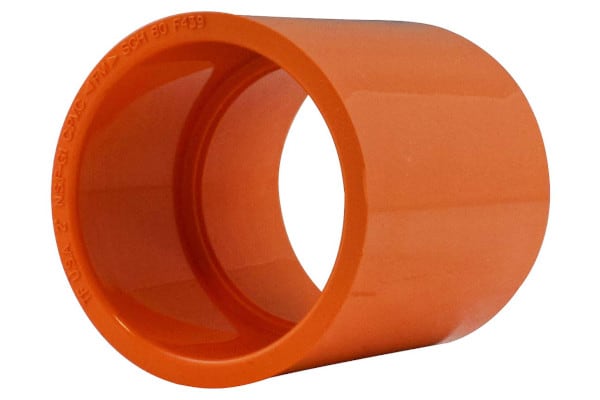
Contractors will have to a use a different kind of adapter to connect to metal threaded pipes (such as a water source or, in some cases, a metal junction of pipe) at a 90° angle. In addition, they may find that elbow adapters are needed to install a sidewall or upright sprinkler at the required angle.
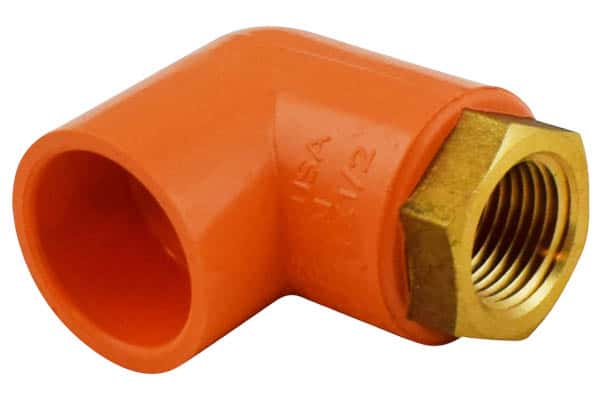
The 90° above is also a “drop” (called a “threaded adapter,” aka “terminal end”) which connects the end of a pipe to a sprinkler.
Installers can use CPVC tees (known as T-junctions) to allow water to flow in two directions from a single source and to branch off from the main line. Tees available for purchase online from QFRS are sized from 3/4” to 3,” and reducing tees are available in sizes 3/4”x 3/4″ x 1″ and 2″ x 2″ x 1-1/2.”
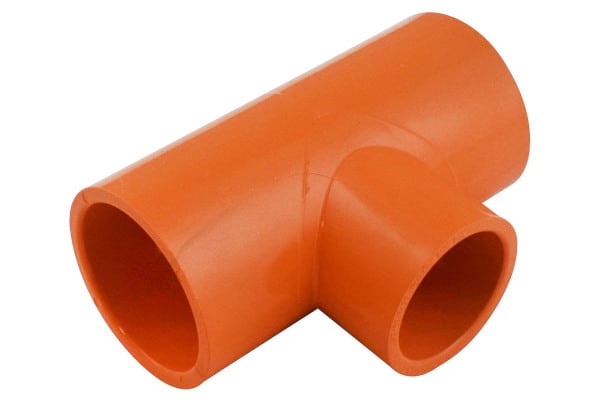
One important note to remember: once a new system is installed and the joints are properly cured, installers must perform at least one hydrostatic test to verify the system’s integrity against leaks.
If you are building, expanding, or repairing a thermoplastic home sprinkler system, take a look at the CPVC components that QFRS carries—all are listed.
QFRS also carries CPVC pipes and fittings that are not yet on the site. For more information on CPVC components or to purchase additional items, please contact us at 1-888-361-6662 or email support@qrfs.com.
This blog was originally posted at blog.qrfs.com. If this article helped you, check us out at Facebook.com/QuickResponseFireSupply or on Twitter @QuickResponseFS.


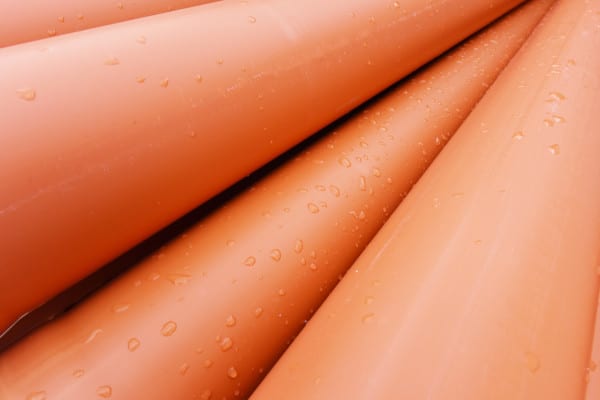
what is the CPVC pipe scheduling or how many sprinkler heads per pipe size
in sprinkler system
Ronnie, thanks for reaching out. For complex standard interpretation questions like this (which involve some calculations), we recommend submitting your question through QRFS Ask A Fire Pro. Click the link to submit your question with some information about your building or system, and a fire protection professional will provide a detailed answer based on standards and codes. Our pros include AHJs, contractors, engineers, and code experts with 150+ years of combined experience!
Is 3M 25WB+ fire caulking compatible with Spears CPVC?
Jason — Spears (and other manufacturers) issue a list of materials, including grease, solvents, etc. that cannot mix with their CPVC, and maintain the most current versions of this list. We suggest reading their tech sheets, the documentation that came with the CPVC, or contacting Spears directly to run the fire caulking compatibility by them: https://www.spearsmfg.com/contact_information/contact_information.html
Love the way you provide the info in depth, Thank you for sharing this blog….
Is there any info or documentation on if grommets or protection is needed for cpvc pipe when it is run through metal C joists? The fear is the metal opening could cut or damage the pipe but didn’t know if required
Jeff — for system installation questions like this, you can try our Ask a Fire Pro service. This question would be the lower price tier. Click the link to submit your question with some information about your building, and a fire protection professional will provide an answer based on best practices, standards, and codes. Our pros include AHJs, contractors, engineers, and code experts with 150+ years of combined experience!
Is fiberglass insulation incompatible with cpvc fire sprinkler piping? We have an uninsulated attic above our garage that I would like to insulate, however, we have Victaulic Firelock cpvc sprinkler piping.
Scott — We aren’t immediately aware of any issues with fiberglass and CPVC (these are both commonly used in homes), but each CPVC manufacturer includes data sheets that specify incompatible materials — so it’s best to check with your manufacturer. They’ll know and verify!
Help! I just installed Flowguard cpvc piping and now I read there are incompatible reactions to both the fire retardant and the foaming catalyst used in the fire resistant spray foam made by everyone including Dap, (which I used), and also there caulking? Flowguard never mentioned any incompatibilities in it’s promotional emails, not even how to isolate the cpvc piping from the foam, caulk, wiring, drywall that allapparently effect the piping they toute as superior to all other forms of piping materials.
How long will the cpvc piping last in direct contact with the fire retardant spray foam, the regular “crack” sealing foam, or the soft wire sheathing that I just sealed up in my wall?
Thank you in advance, dtms.
David — We don’t know how long the CPVC pipe will last in direct contact with the specific items you mention. Certain materials are incompatible with CPVC pipe and can degrade it; in fire protection (CPVC sprinkler pipe), we know should be listed in the manufacturer’s technical documents, and installers are directed by codes and standards to meet these specifications. If the specs weren’t met or the specific items you mention weren’t listed, you should contact the installer and/or manufacturer. In addition, if an item is known to affect pipe integrity, the system will need to be revised at some point, as you do not want a system that leaks or fails in an emergency.
Are CPVC allowed to be used for dry system Sprinklers in light hazard areas such as apartments and hotels?
Rich —
Spears specifies yes here:
Lubrizol Blazemaster is less precise here (specifies residential):
We suggest you contact the manufacturers directly and run your intended application by them:
Spears contact
Lubrizol Blazemaster contact
Thanks!
I live in a fire zone in Southern California and our house is sprinklered already on the interior, so we have sufficient water pressure for a system.
Being that most houses lost in wildland fires start by flames lapping up under the eaves, I’m considering adding a separate system under the eaves. I see there is a concern about sun exposure. Most areas would be shaded from direct sunlight, but some lengths would be in direct sunlight, especially the riser from the source.
Can you give any insight on exterior installation under eaves, etc? Would latex housepaint be safe to help protect from sunlight?
Thanks in advance and best regards,
Ed
Ed — We can’t provide specific installation advice regarding systems; you’ll need to consult a qualified fire sprinkler installer/designer to assess your individual needs. However, a few things: 1. CPVC does not do well with constant exposure to sunlight 2. CPVC reacts negatively to certain substance, and we don’t know whether some may be present in paint; manufacturers have specific guidelines and are a resource. 3. Systems sometimes have a combination of metal and CPVC, with adaptive fittings.
Again, you should contact an installation pro in your area, and they can provide more specific advice for your situation. Thanks for reading!